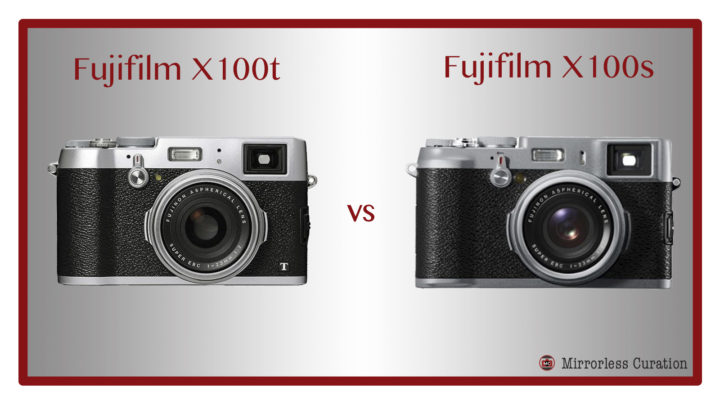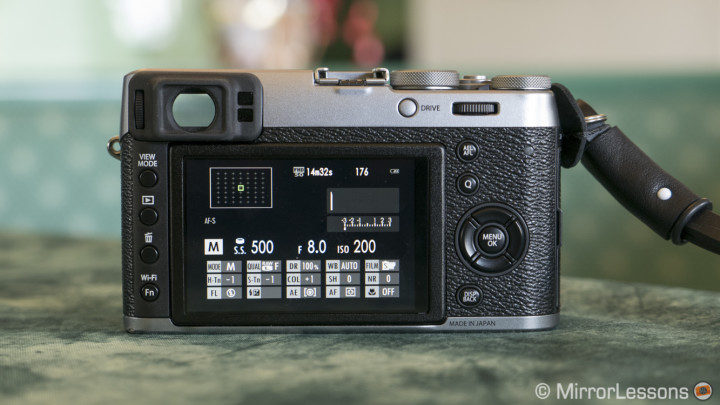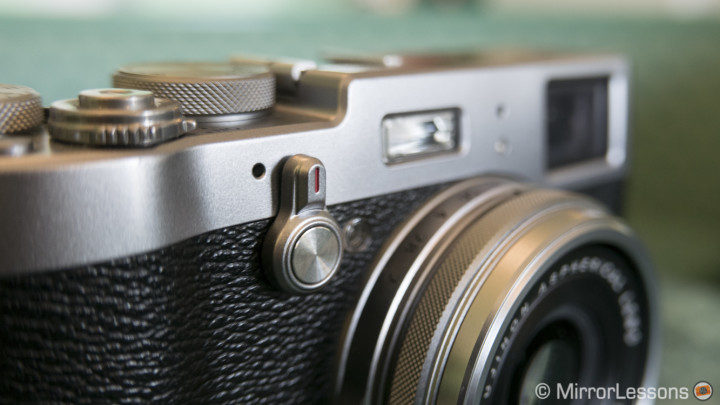
One of the very first cameras we ever reviewed on MirrorLessons was the Fujifilm X100s, and it was literally love at first click. When we weren’t reviewing other gear, it almost always accompanied us on our outings, be it a walk down the street to fetch an ice cream or a longer excursion to a far-away destination. In total, we must have written at least a dozen articles featuring the camera in one form or another.
The fact that we replaced our X100s with its successor, the Fujifilm X100T, was a no-brainer given that we run a review website, but this isn’t the case for the average photographer, who probably wants to buy a camera that fits his or her needs, and stick with it for many years to come.
This is why we wrote this article: to help you decide between these two Fujifilm models by looking at all the most important extra features the X100T has to offer in comparison to the previous iteration. We hope you find it useful!
Ethics statement: The following is based upon official specifications and our personal experience with Fujifilm cameras. We were not asked to write anything about these cameras, nor were we provided with any sort of compensation. Within the article, there are affiliate links. If you decided to buy something after clicking the link, we will receive a small commission. To know more about our ethics, you can visit our full disclosure page. Thank you!
1. Updated advanced hybrid viewfinder with ERF

The hybrid optical / electronic viewfinder is a star feature of the X100 series, making its first appearance on the original X100 in 2010. On the X100T, it has been updated in a couple of ways compared to the X100s as we’ll see below.
First, in addition to having the optical viewfinder and electronic viewfinder of the X100s, the X100T also incorporates an ERF mode which gives you the best of both worlds: it projects a small electronic viewfinder in the bottom right-hand corner when you use the optical viewfinder so you can easily check your framing and focus.
Additionally, the camera now provides smoother real-time parallax correction when you turn the lens ring in manual focus mode. The OVF also has a 92% field coverage instead of 90% on the X100s.
Finally, although the EVF resolution of 2,360K-dots remains the same, the X100T version has a faster refresh rate and a reduced time lag.
As for their similarities, both have an eye sensor that activates the viewfinder when you lift the camera to your eye to shoot.
2. Updated LCD screen

The second difference is also physical, and relates to the rear TFT colour LCD monitor.
While the X100s had a 2.8-inch screen with 460K-dots of resolution, the X100T is bigger, sharper and clearer at 3-inches in length with 1040K-dots of resolution.
Another bonus is the increase in dynamic range in the live view to from 100% to 400%.
Sadly, neither screen articulates and both lack touch sensitivity. Since the X70 has both these features, they will hopefully come to the next iteration.
3. Addition of electronic shutter
Both cameras have a quiet mechanical leaf shutter that can shoot up to 1/4000s but only the X100T comes with a silent electronic shutter that goes as high as 1/32000s. This speed is available at all apertures.
If you choose the mechanical / electronic shutter option in the menu, the camera will automatically shoot with the mechanical shutter up to 1/4000s and only switches over to the electronic shutter for shutter speeds that exceed 1/4000s.
Having an electronic shutter makes it easier to shoot at very wide apertures on bright, sunny days. It can also helps to overcome a limit of the leaf shutter where a fast aperture and very fast shutter speed can produce some distortion in the bokeh (for example, if you shoot above 1/1000s at f/2).
4. Addition of “Classic Chrome” Film Simulation Mode

Fujifilm’s colour profiles, or Film Simulation Modes as they are called, are unique and give your out-of-camera JPGs a very interesting look. Many say that they have a more “organic” or “less digital” appearance than colour profiles from other brands.
The latest colour addition is Classic Chrome and it is only available on the most recent Fujifilm models, including the X100T. With its subtle, muted colour palette but strong contrast, this FSM is most appropriate for street and documentary photography where the action taking place rather than the colours or tones is the primary focus of the image.
The X100s does not have Classic Chrome and Fujifilm has stated that it will not receive it via firmware update.
5. Better video functionalities
The video quality hasn’t changed since the sensor is the same but the basic functions have been greatly improved on the X100T compared to the X100s. (Though it should be said that they don’t come close to what the likes of Panasonic and Sony have to offer.)
The camera can now shoot in 1080p at 60fps, 50fps, 30fps, 25fps, and even 24fps for a more cinematic look. What’s more, it is now possible to change the exposure (aperture, shutter speed and ISO) while recording and use the OVF in video mode.
To complement the improved video mode, the X100T also comes with an external mic jack so that you can record with an external microphone.
6. WiFi capabilities
By downloading the Fujifilm app to your smart device, you can wirelessly control the X100T. This includes exposure control, live view and touch focusing, as well as the possibility to transfer your images from the camera to your device.
The X100s does not have WiFi but it does support Eye Fi memory cards for easy wireless transfer of images to your computer. It works well, but it is definitely more convenient to have WiFi built into the camera.
7. Physical changes to dials and buttons
Although the two cameras look overwhelmingly similar, close inspection will reveal that a few minor aesthetic changes have been made to the X100T body in comparison to the X100s. Below I’ll list the most obvious.
Many of the rings and dials around the body now have a cross-hatched texture that is easier to grab, and the tightness of certain dials has been improved. The OVF/EVF toggle has been restored to how it looked on the original X100 and the rear command dial is now a proper dial instead of just a toggle.

In the place of the X100s’ single function button, there are now a total of seven on the X100T, all of which are customisable. These function buttons can also be customised to seven different functions.
The exposure compensation dial found on top now provides 3+/- stops of exposure compensation compared to the X100s’ 2 stops, and can be used in manual mode. The aperture ring has been given 1/3 aperture stops, while the shutter speed dial now features a 1/2 second and 1 second option.

Fujifilm has also done away with the rotary dial and replaced it with a D-Pad consisting of four buttons. Happily, the four-way control pad can be configured to directly change the AF point.
There are a few other very minute changes but overall, the two cameras look practically identical.
8. Slightly faster Hybrid AF
Although the X100T and X100s have the same hybrid AF system with contrast and phase detection points, the X100T autofocus is slightly faster and more responsive than that of the X100s. That said, the autofocus of both cameras isn’t as fast as some of the competition in the mirrorless sector.
Also enhanced for autofocus is the new Multi-Target Auto Area AF (formerly Multi AF in the X100s), whereby the camera determines subjects from multiple focus points, and variable target area during manual focus, which allows you to freely set the focus area in MF mode.
9. Extra features
The X100T wouldn’t be the successor to the X100s if it didn’t have an array of new features. These include an updated user interface, customisable Q menu, interval shooting for time lapses, focus peaking with colours, release priority in the AF menu, face detection, and a higher extended ISO of 51200 to accompany the already-existing values of 100, 12800 and 25600.
10. Price
The final difference is, of course, the price. The X100T was released in September 2014 and the X100s, more than a year before that, so although you can find both models second-hand at a more reasonable price than when they were first released, the X100s is still the less expensive of the two.
Given that we’re already halfway into 2016, my guess is that we will see the next iteration of the X100 series sooner rather than later – perhaps in time for this year’s Photokina. The release of a fourth model would certainly push the price of the X100T and X100s down even further.
Conclusion
If we take a step back and look at the two cameras side-by-side, there are admittedly very few differences that could drastically influence your decision. In fact, I can only think of two that would affect me personally: the new Classic Chrome film simulation mode, because it really is one of the best colour profiles on offer, and the addition of WiFi.
Our hope is that many of the upgrades given to the flagship Fujifilm X-Pro2, which was released earlier on this year, will carry over to the next iteration of the X100 series such as: the updated autofocus system, new X-Trans III sensor with its 24MP, black and white Acros film simulation mode, and perhaps even that wonderful AF toggle everyone is raving about.
You can check the price of the X100s and X100T at B&H Photo.
